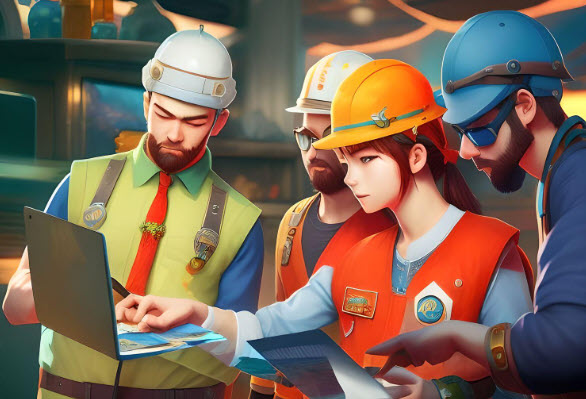Safety in the workplace is a critical concern for every organization. Much like the double-helix structure of DNA, ladders and work platforms can be viewed as a complex intertwining of many elements. Elements include:
- Inherent risks.
- The tradeoffs of different safety measures.
- The importance of making well-informed decisions about their use.
One of the most effective ways to ensure workplace safety is through risk assessments. Risk assessments enable organizations to identify risk factors and take corrective steps to eliminate or control them. Effective risk assessments require providing satisfactory working conditions, limiting exposure to potential hazards through personal safety equipment and ergonomic workplace design, conducting medical surveys, and complying with technical and safety standards. Employers are responsible for ensuring that workplaces are safe for workers. However, ensuring workplace safety can be challenging. Many scientists have called for the development of new and improved tools to assess risks in the workplace.

For example, a study by Perlman, Sacks, and Barak found that experienced workers who regularly used ladders underestimated the risk of falling. As such, there is a need to develop innovative methods for assessing workers’ hazards and improving workplace safety levels. Ladders, in particular, have well-documented safety concerns. These concerns include the absence of fall protection for users, difficulty in securing fall restraints, and previous ergonomic studies on ladder use.
The DNA of Workplace Safety
In the DNA of workplace safety, ladders and work platforms are integral components, contributing directly to an organization’s overall health and functioning. Yet, just as the smallest mutation in DNA can lead to significant outcomes, a minor overlook in ladder safety can have serious consequences.
Ladders, when not properly managed, can contribute to a range of safety incidents, including falls that can lead to severe injuries or even fatalities. According to OSHA, falls remain one of the leading causes of work-related injuries and deaths.
Conversely, ladders and work platforms are essential tools for many industries, and they allow workers to reach heights for maintenance, construction, and warehouse operations. Thus, eliminating their use is not a feasible solution. The challenge lies in striking a balance between maintaining productivity and ensuring worker safety.
Various factors influence this balancing act. For instance, the choice of a ladder or work platform should be dictated by the specific task at hand, the duration of use, and the environmental conditions. A more than one-size-fits-all approach is needed to address the unique risks associated with different settings and tasks.
In addition to choosing the right equipment, proper training is a significant factor in mitigating risks associated with ladders. Workers need to be educated about the correct usage and placement of ladders, recognize potential hazards, and understand the importance of routine inspections for wear and tear.
Decoding the Genetic Blueprint of Safe Work Environments
Continuing with our DNA metaphor, let’s dive deeper into the genetic blueprint for creating safe work environments. Just as every living organism relies on its unique DNA for structure and function, a safe workplace result from carefully combined elements.
The first strand of this blueprint is the physical environment itself, including the tools and equipment—like ladders and work platforms—used by workers. This equipment must be robust, reliable, and fit for purpose. A simple change like switching from a standard ladder to one with wider steps and better grip can substantially reduce the risk of falls. Regular equipment inspections and timely maintenance are also crucial in detecting and fixing any potential issues before they become serious hazards.
Parallel to this physical strand is a behavioral strand, focusing on the actions and attitudes of employees. This is where comprehensive training programs come in. They serve not only to equip employees with knowledge and skills but also to foster a safety-conscious culture. It’s important to remember that safety behavior is not just about following rules but understanding why they exist.

In our DNA analogy, these two strands twist around each other, shaping the double helix structure of a safe work environment. They are interconnected and interdependent—quality equipment is useless without proper usage, and the most extensive training can’t compensate for faulty equipment.
The third element, the equivalent of the bonds connecting the two strands, is the organization’s safety policies and procedures. These policies provide a framework that guides the integration of physical and behavioral safety elements. They should be clear, accessible, regularly reviewed, and updated as necessary.
And finally, just as DNA replication ensures life’s continuity, regular audits and reviews safeguard the continuity of safety practices. This process checks the integrity of the safety ‘genome,’ identifies areas for improvement, and helps adapt to changing circumstances.
So, decoding the genetic blueprint of safe work environments reveals a complex but harmonious interplay of physical, behavioral, and procedural elements. It’s a dynamic structure, constantly evolving to adapt to new challenges and changes—much like the DNA it metaphorically represents.
Mutations in Workplace Safety: Identifying and Addressing Hazards
We can think of workplace hazards as mutations in the genetic code of safety. Just as mutations can profoundly affect an organism, risks can significantly impact the safety and well-being of employees.
Identifying these ‘mutations’ or hazards is the first step in addressing them. This process can involve various techniques, from conducting routine safety inspections and audits to encouraging and facilitating incident reporting by employees. Just as genetic screening can identify potential DNA mutations, these strategies can help identify potential hazards before they cause accidents or injuries.
However, more than identification is required. It’s also crucial to understand the nature of these hazards. What are their potential effects? Who is at risk? Under what circumstances do they pose a threat? This process is akin to the role of researchers who, upon identifying a genetic mutation, work to understand its potential impacts.
Once a hazard is identified and understood, the next step is to address it. This can take various forms depending on the nature of the threat. It may involve physical changes, such as replacing faulty equipment or redesigning a workspace. It could also apply behavioral changes, like providing additional training or changing work practices. In our DNA metaphor, these interventions are like therapies designed to counteract the effects of a mutation.
Just as DNA is continuously subject to mutations, new hazards can arise in the workplace at any time. A crucial aspect of managing workplace safety, therefore, is constant vigilance. Regular reviews and updates of safety protocols, ongoing hazard identification and risk assessments, and continual reinforcement of safe work practices are all essential components of this process.
In summary, ‘mutations’ in workplace safety – or hazards – are a natural part of any work environment. But with proactive identification, thorough understanding, and effective addressing of these hazards, we can maintain the health and safety of the workplace – our ‘organism’ in this metaphor. This ensures the genetic code of safety remains strong, creating a resilient work environment that can adapt and thrive in any challenge.
Splicing Safety Genes: Implementing Best Practices in Your Organization
Drawing upon our DNA metaphor, implementing best practices in your organization is like splicing safety genes into your workplace’s genetic code. As gene splicing can introduce beneficial traits, embedding best safety practices can promote a healthier work environment.
To begin this ‘splicing’ process, let’s identify the safety ‘genes’ or best practices:
- Risk Assessment: A thorough risk assessment is the foundation of any safety program. This process identifies potential hazards, evaluates the risk associated with each, and determines appropriate control measures.
- Regular Training: Regular safety training sessions ensure employees understand safety protocols and know how to operate equipment safely, including ladders and work platforms. Training should be ongoing and adaptive to address emerging risks or changes in work practices.
- Engaging Employees: Safety is a team effort. Creating a culture where employees feel comfortable reporting potential hazards and actively participating in safety discussions enhances safety performance.
- Investment in Equipment: Investing in high-quality, safety-enhanced equipment may seem costly upfront, but it pays off in the long run by reducing accidents and injuries.
- Establishing Clear Protocols: Clear, concise, and accessible safety protocols can guide employees in daily tasks and in case of emergencies. They also demonstrate an organization’s commitment to safety.
- Frequent Inspections: Regular inspections and maintenance of equipment, including ladders and work platforms, can prevent equipment failures that may lead to accidents.
- Emergency Planning: An effective safety program prepares for the worst. This includes planning for potential emergencies, providing first-aid training, and establishing evacuation procedures.
‘Gene splicing’ these best practices into your organization’s DNA takes time and requires commitment, resources, and time. Each organization will have unique challenges and requirements, so customization is key. For example, an inclusive workplace should have handicap ramps. Practices should not merely be adopted but adapted to fit the unique genetic makeup of the organization.

Over time, these spliced ‘safety genes’ will express themselves as fewer accidents, a healthier workplace culture, and more efficient operations. By doing so, your organization strengthens its genetic code of safety, creating a blueprint for success that prioritizes the well-being of all members of your work’ organism.’
The Genome of Safety: Charting a Path Towards Healthier Workplaces
As we unravel the DNA of workplace safety, we’ve discovered that ladders and work platforms are integral components, playing a significant role in productivity and worker safety. Much like the complex double-helix structure of DNA, workplace safety is an intricate interplay of physical, behavioral, and procedural elements.
We’ve learned that minor ‘mutations’ or hazards in this structure can lead to significant consequences. Identifying, understanding, and addressing these ‘mutations’ are critical to maintaining a healthy work environment.
Moreover, implementing best practices—splicing’ safety genes’ into the genetic blueprint of an organization—is an effective strategy for enhancing workplace safety. Though this process requires time, resources, and commitment, the resulting decrease in accidents and improvements in workplace culture are well worth the effort.
In conclusion, much like a geneticist studies DNA to understand the workings of life, we must learn and understand the intricate structure and components of workplace safety to create healthier, safer work environments. This ongoing and evolving process calls for constant vigilance, regular updates, and active engagement from all members of the organization.
By embracing this approach, businesses can successfully navigate the DNA of workplace safety, ensuring that the health and well-being of employees—our most valuable assets—are always placed at the forefront. In doing so, we create safer workplaces and set a strong foundation for increased productivity, job satisfaction, and overall business success.